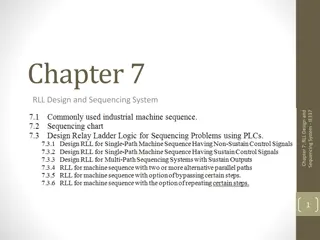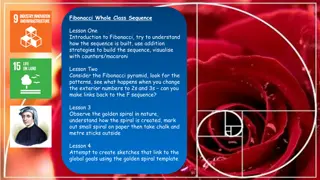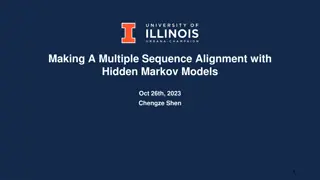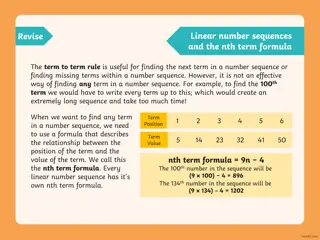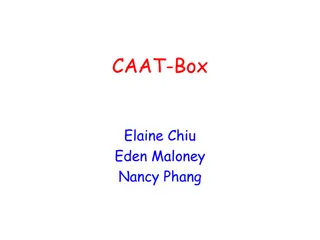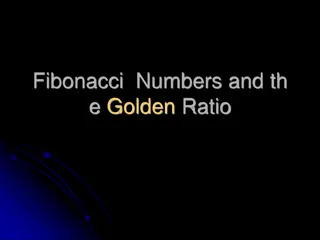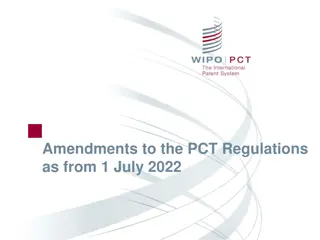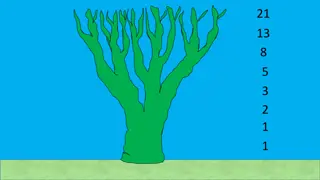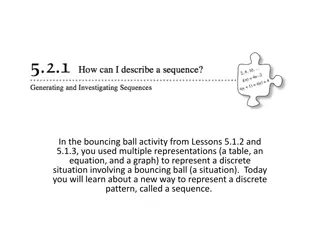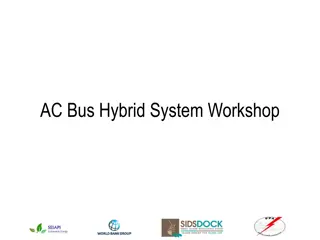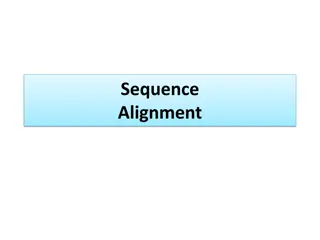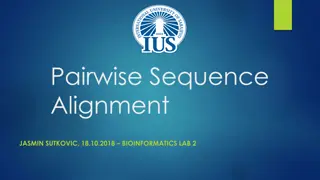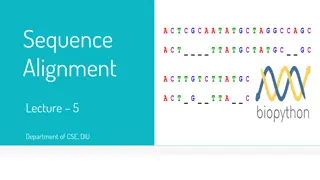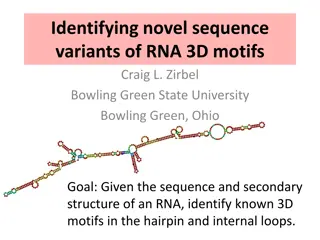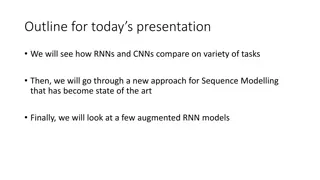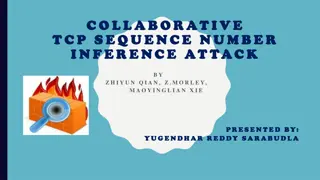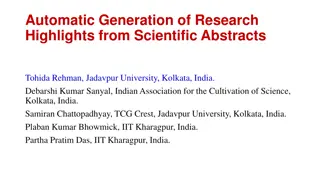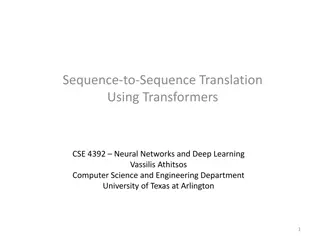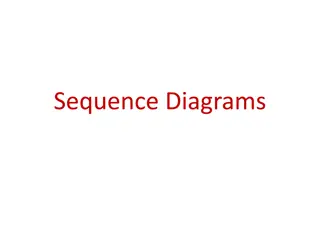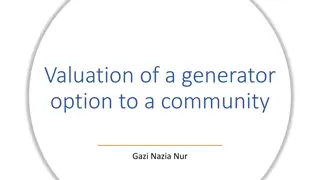RLL Design and Sequencing System Overview
Common industrial sequences in RLL design and sequencing systems involve single path or multi-path approaches. Control signals can be sustain or non-sustain, impacting the system's memory. Sequence charts help visualize system operations, aiding in RLL design. Techniques like the CASCADE method are
13 views • 24 slides
Understanding Binary Counters and Types of Counters
Binary counters are registers used to count clock pulses, while binary counters follow the binary number sequence. There are two types of counters: serial/asynchronous counters and parallel/synchronous counters. Serial counters change output flip-flop to next flip-flop, requiring minimal hardware bu
11 views • 21 slides
Bioinformatics
Bioinformatics involves analyzing biological sequences through sequence alignment to uncover functional, structural, and evolutionary insights. This process helps in tasks like annotation of sequences, modeling protein structures, and analyzing gene expression experiments. Basic steps include compar
0 views • 6 slides
Unraveling the Fibonacci Sequence: Lessons in Mathematics & Nature
Join us on a journey through the enigmatic Fibonacci sequence with engaging lessons on its construction, exploration of mathematical patterns, observations of the golden spiral in nature, and creative activities linking to global goals. Discover the legacy of Fibonacci, the Italian mathematician, an
1 views • 17 slides
Buy 145 ENGINE WELDER GENERATOR Online - marcosengines.com
The Lincoln Outback 145 Engine Welder Generator built for the outdoors. It is a good option for service trucks, fence contractors, farmers, ranchers, maintenance crews, and anyone else who needs portable DC stick welding and AC generator power. Phone: (929) 376\u20137413 Email: info@marcosengines.co
3 views • 3 slides
Understanding Multiple Sequence Alignment with Hidden Markov Models
Multiple Sequence Alignment (MSA) is essential for various biological analyses like phylogeny estimation and selection quantification. Profile Hidden Markov Models (HMMs) play a crucial role in achieving accurate alignments. This process involves aligning unaligned sequences to create alignments wit
0 views • 29 slides
Understanding Linear Number Sequences and the Nth Term Formula
In mathematics, linear number sequences can be described using the nth term formula, which helps in predicting sequences and finding specific terms without generating the entire sequence. By understanding the relationship between term positions and values, one can efficiently determine any term with
1 views • 15 slides
Understanding Transcription Factors and Regulatory Sequences in Gene Expression
Transcription factors play a crucial role in gene expression by controlling the recruitment of RNA polymerase. Promoter regions contain sequences like CAAT box and TATA box that regulate transcription by binding proteins. Consensus sequences are conserved patterns in the genome with various biologic
2 views • 10 slides
Understanding Fibonacci Sequence and the Golden Ratio
Fibonacci numbers are a sequence of numbers starting with 0, 1, where each number is the sum of the two preceding numbers. This sequence, discovered by Leonardo Fibonacci, displays a fascinating relationship to the Golden Ratio when examining the ratios of consecutive numbers. The Golden Ratio, appr
1 views • 55 slides
Advanced Sequence Analysis with BioEdit Software
BioEdit Software is a versatile tool for sequence alignment and analysis, offering features like color customization, information-based shading, and integration with other programs like ClustalW and Blast. Through its intuitive and graphical interface, users can easily compare sequences, perform Clu
0 views • 12 slides
Understanding HR Diagrams in Astronomy
HR diagrams, named after astronomers Hertzsprung and Russell, depict stars' properties and relationships. The main sequence in the diagram shows where stars lie while fusing hydrogen to helium in their core. Learn about different types of stars and their positions on the diagram. Explore the signifi
0 views • 27 slides
Proposed Enhancements for Generator Interconnection Process
Enhancements proposed for the generator interconnection process include creating a distinction between large and small generators, establishing tracking processes for small generators, and modifying existing sub-sections to incorporate small and large generators in Sections 5 and 6. The goal is to s
1 views • 12 slides
PCT Rule Amendments Effective from 1 July 2022
Key amendments to the PCT Regulations as of 1 July 2022 include changes to sequence listings, language requirements, additional mandatory qualifier values, and the handling of free text in applications. Rule adjustments also introduce the use of a new Standard Tool for standard-compliant sequence li
0 views • 4 slides
Discussion on WLAN Sensing Sequence Design in IEEE 802.11-20/1328r0
This presentation by Rui Du from Huawei discusses the design of sequences for WLAN sensing in IEEE 802.11 standards. It covers topics such as existing sequences, analysis of sequences, ambiguity functions, Golay sequences, and properties adopted for communication sequence design.
4 views • 14 slides
Understanding UML Sequence Diagrams and Their Applications
UML sequence diagrams depict how objects interact in a given scenario, showcasing messages sent between targets on lifelines. They are valuable for detailing use cases, modeling logic, task flow between components, and understanding process functionality. Objects, boundaries, controls, and stereotyp
1 views • 30 slides
Understanding Sequence Generators in Digital Circuits
Explore the concept of sequence generators in digital circuits, focusing on PN sequence lengths, feedback taps, XOR gates, and designing patterns with examples and visual aids, including Karnaugh maps.
0 views • 6 slides
Exploring Fibonacci Sequence, Bee Hives, and Squares in Nature
Discover the fascinating world of Fibonacci sequence through the lens of bees, sunflowers, and mathematical patterns in nature. Learn about the Fibonacci numbers, bee colonies, the beauty of sunflowers, and the mathematical properties of squares. Dive into the history of Leonardo of Pisa and his con
0 views • 16 slides
Updates on Generator Interconnection Procedures and Agreements Reform
ISO-NE is implementing further compliance reforms in response to FERC Order No. 845 regarding Generator Interconnection Procedures and Agreements. This includes proposed tariff language updates and discussions on surplus interconnection services. The changes aim to enhance the efficiency and effecti
0 views • 14 slides
Enhancing Generator Telemetry Transparency for ERCOT
This document discusses telemetry issues, recommendations for generator systems, and a proposed solution (NPRR 1085) to improve ERCOT's system health transparency. It highlights the need for better communication of uncertainty in telemetry, clarity in updating telemetry, and mechanisms to align gene
0 views • 14 slides
System Sequence Diagrams: Understanding Artifact for System Behavior
System Sequence Diagrams (SSDs) are vital artifacts that visually illustrate input and output events related to a system. They help define system behavior and interactions, making them essential during the logical design phase of software applications. By depicting events in sequential order, SSDs o
2 views • 24 slides
Effects of Cue-Do-Review Sequence on Teaching Assistant and Student Perceptions
This study explores the impact of the Cue-Do-Review sequence on teaching assistant and student perceptions of learning. The process involves TAs completing surveys, professional development sessions, implementing the sequence, and final surveys. Results show changes in perceptions before and after i
0 views • 12 slides
Exploring Sequence Patterns Using Different Representations
Samantha explores sequence patterns with a sequence-generating machine starting with 2 rabbits. She analyzes the pattern, predicts the next terms, and starts a new sequence with an initial value of 5. Join her in creating and organizing sequence families based on growth patterns, finding sequence ge
0 views • 6 slides
Modeling Water Leak into Sodium in BN-600 Steam Generator
This paper discusses the modeling of a water leak into sodium in the BN-600 steam generator during a specific incident in 1982. It compares calculated data with leak detection system indications and analyzes hydrodynamic parameters in the second sodium circuit. The study utilized SLEAK and LLEAK-3C.
10 views • 9 slides
Design Overview of AC Bus Hybrid System Workshop
This content provides a walkthrough of the design decisions involved in an AC Bus Hybrid System Workshop, focusing on the use of a generator and PV array. It covers the scenario of a village using a diesel generator, customer requirements, site information, system arrangement, and more to help under
0 views • 51 slides
Understanding Sequence Alignment in Genetics
Sequence alignment is the comparison of DNA or protein sequences to highlight similarities, often indicating a common ancestral sequence. This process is essential in determining homology and functional similarities between sequences. Types of alignment include global and local alignment, with chall
0 views • 6 slides
Understanding Sequence Alignment and Tools in Bioinformatics
Explore the concepts of homology, orthologs, and paralogs in bioinformatics, along with different types of sequence alignment such as global, local, and semi-global. Learn about popular alignment tools like Blast and Fasta and how they are used for analyzing sequences. Dive into the world of NCBI an
0 views • 32 slides
Understanding Sequence Alignment Methods in Bioinformatics
Sequence alignment is crucial in bioinformatics for identifying similarities between DNA, RNA, or protein sequences. Methods like Pairwise Alignment and Multiple Sequence Alignment help in recognizing functional, structural, and evolutionary relationships among sequences. The Needleman-Wunsch algori
0 views • 18 slides
Understanding EMBOSS Needle: Pairwise Sequence Alignment Tool
EMBOSS Needle is a pairwise sequence alignment tool that uses the Needleman-Wunsch algorithm to find the optimal global alignment between two input sequences. It is available online through EMBOSS and requires entering two protein/DNA sequences of the same length to generate alignment results, inclu
0 views • 11 slides
RNA 3D Motif Analysis: Novel Sequence Variants Identification
A research project at Bowling Green State University aims to identify 3D motifs in RNA hairpin and internal loops using sequence and secondary structure information. The study focuses on finding likely sequence variants of known motifs, leveraging geometric considerations and basepair isostericity f
0 views • 28 slides
Understanding Sequence Alignment and Scoring Matrices
In this content, we dive into the fundamentals of sequence alignment, Opt score computation, reconstructing alignments, local alignments, affine gap costs, space-saving measures, and scoring matrices for DNA and protein sequences. We explore the Smith-Waterman algorithm (SW) for local sequence align
0 views • 26 slides
Exploring RNNs and CNNs for Sequence Modelling: A Dive into Recent Trends and TCN Models
Today's presentation will delve into the comparison between RNNs and CNNs for various tasks, discuss a state-of-the-art approach for Sequence Modelling, and explore augmented RNN models. The discussion will include empirical evaluations, baseline model choices for tasks like text classification and
0 views • 20 slides
Integrating Stochastic Weather Generator with Climate Change Projections for Water Resource Analysis
Exploring the use of a stochastic weather generator combined with downscaled General Circulation Models for climate change analysis in the California Department of Water Resources. The presentation outlines the motivation, weather-regime based generator description, scenario generation, and a case s
0 views • 20 slides
Exploring Wind Energy Systems Without Gearbox - Research Findings
Investigating wind energy systems without a gearbox reveals insights on turbine performance and generator efficiency. The data generated highlights differences in output power, current, and RPM between ideal and actual setups. Higher RPM allows for a wider selection of generators, although the curre
0 views • 5 slides
Understanding TCP Sequence Numbers and Attacks
Explore the fundamental concepts of TCP sequence numbers and inference attacks, along with the design, implementation, and impact analysis of TCP attacks. Delve into the significance of TCP fields, the three-way handshake process, as well as sequence and acknowledgment numbers to gain a comprehensiv
0 views • 35 slides
Automatic Generation of Research Highlights from Scientific Abstracts
Huge growth in scientific publications has made it challenging for researchers to keep up with new research. This project focuses on automatically constructing research highlights from paper abstracts using deep learning models. The system employs sequence-to-sequence models with attention and point
0 views • 9 slides
Transformer Neural Networks for Sequence-to-Sequence Translation
In the domain of neural networks, the Transformer architecture has revolutionized sequence-to-sequence translation tasks. This involves attention mechanisms, multi-head attention, transformer encoder layers, and positional embeddings to enhance the translation process. Additionally, Encoder-Decoder
0 views • 24 slides
Analysis of Key Elements in the Opening Sequence of "Higher English
The opening sequence of "Higher English" delves into the intricate themes of control, power, deception, and the clash between Italian tradition and American values. Through the characters and dialogues, the sequence explores concepts of justice, violence, crime, corruption, honor, family, and the Am
0 views • 23 slides
Understanding Sequence Diagrams in Software Development
Sequence diagrams depict the sequence of actions in a system, capturing the invocation of methods in objects. They are a valuable tool for representing dynamic system behavior. Message arrows in sequence diagrams indicate communications between objects, illustrating synchronous and asynchronous mess
0 views • 21 slides
Valuation of Adding a Generator Option to a Community
This study focuses on evaluating the option value of adding a generator to a community's network, specifically at bus 1. The valuation is conducted by analyzing how electricity demand evolves over time and utilizing tools like demand lattice to map out future probable demand scenarios. The aim is to
0 views • 26 slides
Comparison of Generator Governor Dead-band Settings in ERCOT Interconnection
This report compares the generator governor dead-band settings in the ERCOT Interconnection for the years 2008 and 2015 from January to November. It outlines the changes in the dead-band settings over the years, including the requirements for proportional response, improvements in primary frequency
0 views • 17 slides
